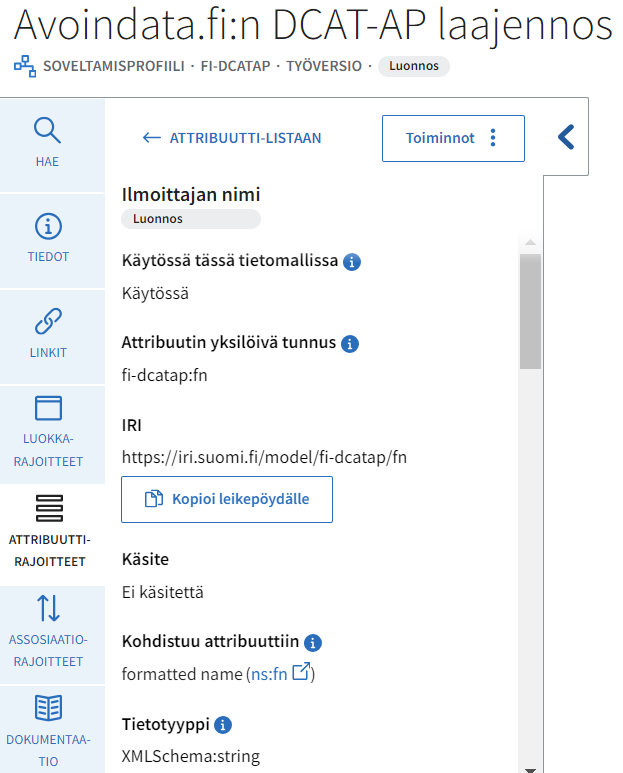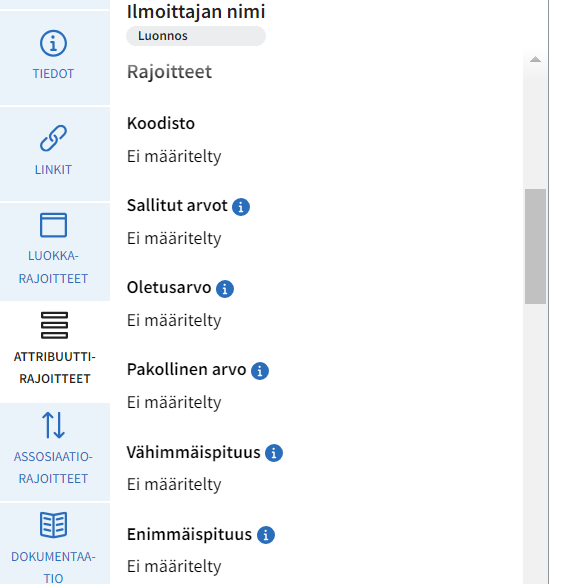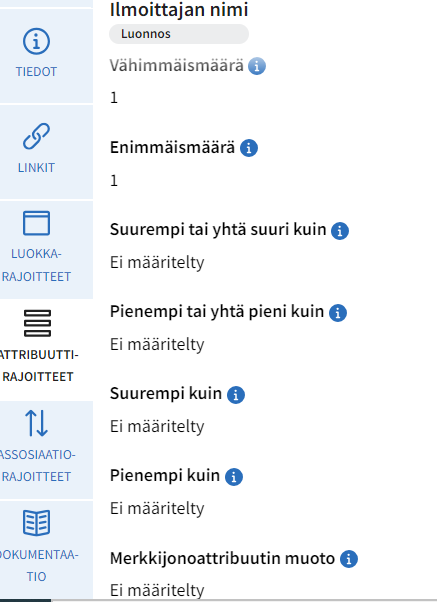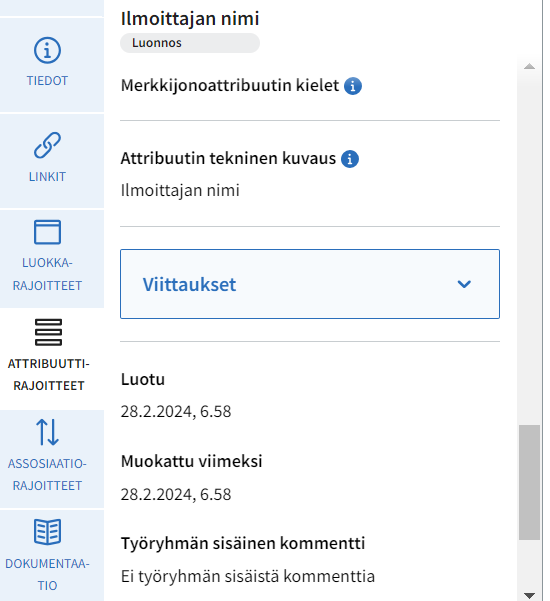The tool lists to the Attribute restrictions tab the number of attribute restrictions as well as the list of attribute restrictions that are utilised in the data model.
Click the title of the attribute restriction to open more specific details of the attribute restriction, for example:
- Name of the attribute restriction
- Icon that shows the status of the data model
- In use in this data model
- A switch that indicates, if the resource that is generated from a data vocabulary must be used in this class.
- If the value is In use, the resource is shown in the technical schemes (JSON etc.), in the visualisation of the data model and it is also used in the class validation.
- Attribute’s identifier
- Identifier for the attribute restriction in the Data Vocabularies Tool.
- The long identifier, IRI-address: IRI-address is a unique address for the attribute restriction on the internet.
- With the IRI-address the attribute restriction can be used as a reference also outside of the Data Vocabularies Tool, for example in machine-readable interfaces.
- Concept: the link to the concept in the Terminologies Tool if the link has been added.
- Target attribute
- Reference to the attribute in the core vocabulary that forms the basis of the attribute restriction in this data model.
- Data type
- Defines the range of the attribute restrictions values. For example, it can be required that the value must be an integer, a string, an URI, a date etc.
- Restrictions/properties that define the attribute restriction:
- Code list: Link to the code list in the Reference Data tool, if this attribute restriction is linked to a code list, which provides the range of values for this restriction.
- Allowed values: List of values that are allowed for the attribute. E.g. blue, white, green.
- Default value: Default value of the attribute that may be used if no other value is manually given.
- Required value: Fixed value for the attribute that is always required. This value must be included in the data.
- Minimum length: Minimum length of the attribute value.
- Maximum length: Maximum length of the attribute value.
- Minimum count: Cardinality restriction indicating the minimum count of the attributes. For example, 0 indicates that attribute is optional and not necessarily needed; 1 indicates that there must be at least one attribute value.
- Maximum count: Cardinality restriction indicating the maximum count of values of an attribute. For example, 1 when only one value is allowed.; * when the number of values is infinite.
- Larger or as large as: The value of the attribute restriction must be greater than or equal to the value given here.
- Smaller or as small as: The value of the attribute restriction must be less than or equal to the value given here.
- Larger than: The value of the attribute restriction must be greater than the value given here.
- Smaller than: The value of the attribute restriction must be less than the value given here.
- String attribute format: A text field that tells the user of the data model the structure that the string attribute must conform to. For example, an email value must contain an "@" character, or a personal identification number must contain a certain number of digits and an allowed punctuation character.
- String attribute languages: Allowed language tags for each attribute restriction value are limited by a given list of language tags.
- Technical description of the attribute restriction: Short textual description of the attribute restriction and for example its use case.
- References -drop-down menu shows a list of the resources, that have used this attribute restriction.
- Created: The date and time the attribute restriction was created. The users of the contributor organisation can also see the name of the person who created the attribute.
- Last modified at: The date and time the attribute restriction was last updated.
- Work group comment:Comments and instructions for other users editing the information content of the attribute restriction. This field is not publicly available.
- Contributors: Organisation(s) who owns the content and maintains it in the Data Vocabularies Tool.
If you want to give feedback to the contributor organization, click Give feedback of the attribute-link. The Data Vocabularies Tool will open a link to your email, the email of the contributor organisation already given in the recipient field.
If you have editing rights to the tool, you can see Action -menu in the data models of your organization. You can then edit a selected attribute restriction or its prefix. You can also delete the attribute restriction.



